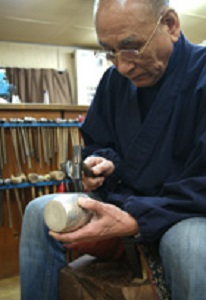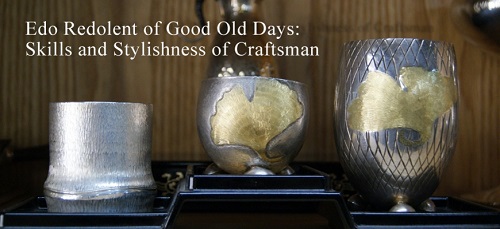Please note: The content of this post is the sole property of JIBTV. It may not be reproduced in any way without consent and is posted here with permission of JIBTV.
*
The central subject of MoshiMoshi Nippon #18 is Tokyo-Ginki, the silver craft of Kazuo Kamikawa, a 10th-generation silver artisan who inherited the name “Sosho” from his father.
The camera takes us into his workshop where he is at work with his four adult children who are also his apprentices. Though he acknowledges that silver is crafted around the world, Kamikawa claims Japan’s silver culture is unique.
However, his claims are vague and unsubstantiated. He does not elaborate on the specific points which set Japanese silver culture apart except to say that Japan’s traditional motifs are the root of its charm. The viewers’ curiosity remains unanswered. We are left wondering what specific criteria set Japanese silver work apart. Possibly the long apprenticeships, perhaps specific techniques, but without being told, how is the audience to know?
Viewers see do see stunning objects made by Kamikawa and learn about 500 tools, as well as the hammering and design techniques used to create silver crafts.
One teapot can take a single person two months to make. Because silver craft is expensive, the items don’t appeal to young buyers who prefer trendy items to lasting ones.
Aiming for that market, Kamikawa’s daughter Sochi creates affordable pieces like bookmarks, bracelets and cellphone charms in silver filigree designs. These are rendered in kawaii or “cute” style with hearts, butterflies and roses.
It’s not said, but one doesn’t have to be adept at “reading the air” to sense that the boys make the serious stuff. Also, in the Japanese craft traditions handed down the generations, it is not uncommon for the apprenticed offspring of the master to be strictly curtailed in what they are permitted to do.
In an attempt to broaden their customer base and build appreciation for silver craft, Kamikawa’s workshop also provides classes for adults, children and non-Japanese individuals or groups interested in silver craft.
Kamikawa claims that the items he produces are meant for everyday use; therefore, they are not art. Except for the fact that most people don’t use expensive artisanal items every day, it could be argued that Tokyo-Ginki is art in the sense of mingei the “handcrafted art of ordinary people.” Or it could be classed as mingei if “ordinary” people were persuaded to use high quality items that can last for generations rather than buying trash at the 100 yen (dollar) store. That point is not raised during the program.
While fascinating, this episode of MoshiMoshi Nippon could have been better with greater depth and more probing—in short, better writing. Additional attention could have been given to questions that better address the subject. The Taito City Culture Guidebook online-page featuring Kamikawa does a much better job of showcasing this artist and answering questions than episode #18 of MoshiMoshi Nippon. It’s well worth a look.


